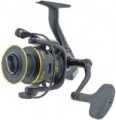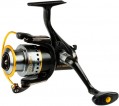Spool capacity
The amount of line that can fit on the main spool of a reel with normal winding. It is indicated as a ratio of two numbers, the first of which corresponds to the length of the reeled line in metres, and the second to the thickness in millimetres: for example, the numbers 200 / 0.45 indicate that up to 200 m of fishing line with a thickness of 0.45 mm can fit on the reel.
For different types of fishing, there are recommendations on the optimal value of this parameter; they can be found in special sources. Here we note that the capacity of the spool is indicated exclusively for a smooth fishing line; when using a braided cord, the actual performance may differ markedly.
Reel material
The material from which the base of the coil is made is the part of the structure on which the spool and other mechanisms are installed.
— Plastic. Plastic is inexpensive, lightweight, corrosion resistant and completely immune to salt water. At the same time, this material is easily scratched, its strength is relatively low, and under the action of ultraviolet radiation in some grades of plastic, it is even more reduced. As a result, plastic is used mainly in entry-level coils that are not designed for difficult conditions and high loads. Usually, its quality directly depends on the price of the product.
— Graphite. Most often, this term refers to a relatively simple type of carbon fiber, which has a low cost and can be used even in low-cost-class models. At the same time, with a small weight, graphite is somewhat stronger and more resistant to certain influences than plastic, and therefore is also found in more expensive products. The quality of this material may also vary depending on the price of the coil.
— Carbon. Another type of carbon fiber, higher grade than graphite. Carbon combines high strength, flexural stability and durability under stress with extremely low weight; in addition, it is completely chemically inert (does not corrode) and tolerates ultraviolet radiation, temperature extremes, etc. well. The main disadvantage of this material can be called a high price, due to which it is used mainly in premium models. Also note tha...t carbon requires quite careful handling, because. does not take a hit well.
— Composite. Composites are materials that combine several separate components that are not mixed with each other (unlike, for example, alloys). In coils, this term most often means a combination of the graphite or carbon fiber described above with fiberglass. Fiberglass, despite the name, bears little resemblance to ordinary glass — it is highly flexible and can withstand bumps and falls without any problems; therefore, the combination of this material with carbon reduces the fragility of the latter. And in the "bundle" with graphite, fiberglass slightly increases the strength of the entire structure. The composite base can be found in models of different price categories — this is due to the difference in the quality of the components used.
— Aluminium. The main advantage of aluminium alloys can be called high strength, due to which this material can be found even in "large-caliber" coils designed for strong and heavy production. However, there are simpler options — again, aluminium alloys come in different types, and their characteristics usually depend on the price. In terms of weight, this material, if it surpasses plastic, is not much, and its corrosion resistance is very good. Of the obvious shortcomings, one can only note a rather high (in general) cost.
— Magnesium. Magnesium-based alloys are premium materials. Their main feature is extremely light weight combined with high strength and reliability, which allows you to create powerful and at the same time quite light coils. On the other hand, such products are expensive, and the material itself does not tolerate contact with salt water, and in general its resistance to corrosion is relatively low (which requires the use of special coatings).
Spare spool material
The material of the
spare spool(drum) supplied with the reel.
Additional interchangeable spools are provided to expand the capabilities of the reel: if necessary, you can quickly replace the fishing line with tackle of a different thickness (or the same one instead of a broken one), install a reduced drum to increase the casting distance, etc. As for the materials for such spools (
plastic,
aluminium,
graphite), they do not differ from those used in the main drums; see the relevant paragraph above for more details.
Weight
The total weight of the reel (only the device itself, without fishing line). This parameter is important, first of all, for those who select equipment of
the ultralight class — in such gear, the struggle is, as they say, for every extra gram. In other cases, you can not pay special attention to weight.

